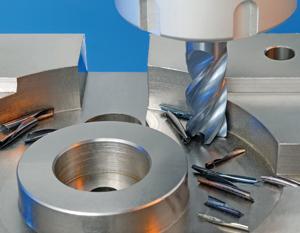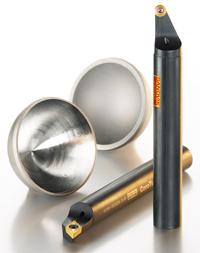- FMA
- The Fabricator
- FABTECH
- Canadian Metalworking
Industry Update: The Health of Canadian Medical Manufacturing
An aging population combined with a more active lifestyle has created a boom in the medical supply industry
- June 1, 2010
- Article
- Management

Parts are made for the medical industry are generally small and therefore require small tooling, such as Iscar's Minicut (shown here).
As the Canadian population ages, the demand for joint replacements, dental implants, prosthetics, and other medical supplies and devices increases. When combined with the desire of today’s manufacturers for diversification, a growth industry has finally been found.
According to Industry Canada, in 2009 the Canadian medical device market was an estimated $5.7 billion, and many experts are predicting that this amount will grow to more than $7 billion by 2014.
A recent North America-wide dip in automotive supply requirements as assemblers restructured and sold off stockpiled vehicles affected thousands of Canadian workers. The aerospace sector, always cyclical in nature, as well as recent initiatives in the power generation industry, are largely dependent on government spending and may not grow in the near future.
However, as the baby boom generation ages, the need for medical devices steadily grows.
According to MEDEC, the national association representing medical device and diagnostics businesses, an estimated 1,500 companies employ more than 35,000 people in this sector, with the hotbeds being Ontario and Quebec. There are, however, major pockets in other regions, usually clustered around universities that are heavily involved in the life sciences.
According to Invest in Canada, a bureau of the Department of Foreign Affairs and International Trade, the nation’s medical device manufacturers draw heavily on research currently being conducted at Canadian universities, research institutes, and hospitals.
In fact, nearly 10 percent of Canadian medical device firms are spinoffs from universities, other established companies, or laboratories.
Toronto, to no one’s surprise, is home to our largest concentration of scientific research, buoyed by several major teaching hospitals. In this geographic location the sector is well-served by local colleges and universities that produce nearly 30,000 graduates a year in mathematics, engineering, and the sciences.
In Quebec, Montreal’s medical technologies industry includes companies focused on radiology, cardiology, orthopedics, oncology, obstetrics, clinical decision assistance, dentistry, and remote surgery. Firms based here can take advantage of the National Research Council of Canada Industrial Materials Institute.
Also according to Invest in Canada, Winnipeg, Edmonton, and Vancouver are also growing regions for this type of work. In fact, science-based infrastructure investments totaling $1.5 billion have taken place in British Columbia recently, including major investments in R&D to enhance the medical industry’s success locally. In addition, Simon Fraser University’s 4D Labs support the industry through its research on advanced materials and nanoscale devices.
In eastern Canada, Halifax is the technology leader. More than $100 million for research is invested each year here from government programs. When those funds are coupled with the work of local universities, colleges, hospitals, and government labs engaged in life sciences work, device manufacturers can reap the rewards.
Medical Manufacturing
“Manufacturing for the medical industry presents its own unique challenges for shops for a few different reasons,” explained Iscar Canada Senior Product Manager Steve Geisel. “Because many of the parts that are created are so small, it places a large burden on these manufacturers and their suppliers. These tools, whether they are mills, turning tools, threading tools, or drills are very difficult to make and very expensive to buy. I would say that the medical industry, more than any other, is very expensive to operate a business in. The tooling, machine tools, and material are all usually at the high end of the cost scale. Because you are dealing with parts that will go into the human body, there is no room for error, and the products that manufacturers use must be able to produce these perfect parts.”
Iscar, for example, has a full line of tooling specifically created for the challenges of small-part creation.
“As the population continues to age, this industry will continue to boom,” said Geisel. “There is a huge opportunity for shops in this country that are looking to diversify into other sectors.”
The declining automotive supply sector likely will never again enjoy the high production levels of the past, but if shops can transfer their machining knowledge base, while taking the time to understand the challenges of medical manufacturing, new, high-value, highly specialized work can be found.
“I think that a majority of Canadians would prefer their medical parts be made here, by our own country’s highly skilled, highly trained, well-paid machinists, rather than in certain low-labor-cost settings where quality cannot be controlled,” said Geisel. “This means that this industry is booming right now, and there are no forecasts that show that it will slow anytime soon.”
The increasing number of parts and devices needed in the near term will create another need for tools with sharp, small-diameter nose radii, because the amount of material that is removed for medical parts is generally small and the material is difficult to machine.
Small Lot Size, Tough Materials
The challenge of manufacturing small lots of complex parts requires careful planning regarding tool selection and order of operations.
For example, if a hole needs to be drilled through a component, and the OD also machined, the part should be turned prior to reducing the wall thickness by drilling. Machines with subspindles and live tooling can complete multiple operations on one machine, which eliminates the need for a secondary setup of the component. These machines also allow tedious operations, such as deburring, to be completed on the machine rather than by hand.
Like machinists in all industries, those in medical manufacturing are looking for tools that offer long tool life but also that create high-quality surface finishes in difficult-to-cut materials.

A requirement for high throughput and improved surface finishes has led to a new generation of tooling.
Materials that are commonplace in medical manufacturing are titanium, stainless steels, and cobalt-based alloys, such as cobalt-chromium-molybdenum (CoCrMo). These difficult-to-cut materials are used to create medical products like fixation screws and bone plates, but also for the major surgery items such as shoulder, knee, and hip replacements.
Poor machinability is one of the hallmarks of these materials
“Titanium and cobalt-based alloys can be up to five times more difficult to machine than a typical mild steel,” explained Sandvik Coromant Canada Product and Application Specialist David Andrews. “As an example, in mild steel you could perform a turning operation at 1,000 SFM, but the same operation would be performed at perhaps 150 to 200 SFM in titanium or cobalt-based materials.”
This is because the characteristics that make these materials good for medical implants are also what make them so difficult to machine: extremely high strength-to-weight ratio, excellent resistance to heat and corrosion, and, for titanium, its nonmagnetic properties.
“Unfortunately, when it comes to machining, the poor heat conductivity of titanium causes most of the heat generated during cutting to be concentrated at the cutting edge, causing rapid wear and deformation of the edge,” said Andrews.
Perhaps most significant of all, added Andrews, is that titanium is more reactive than other high-temperature alloys. The reactive nature of this material can result in a chemical interaction with the tool, which may lead to premature cratering and breakdown of the edgeline.
Productivity gains have been made in the machining of these materials, however. Advancements in carbide manufacturing and coating technology, such as thin physical vapor deposition (PVD) coatings used over a submicron-grain-sized carbide substrate, have led to these gains.
“Thin coatings and small ER [edge rounding] treatment give us a sharp cutting edge, lower cutting forces, and less heat that might lead to work hardening of the material,” said Andrews. “The submicron grain size also makes the carbide substrate under the coating very resistant to heat, thus extending tool life and allowing higher cutting speeds.”
Fixturing Medical Parts
Fixturing plays an important role in the stability of the component during the cutting process. Because so many medical parts are tiny and slender, the fixtures need to support them as much as possible in order to have a stable machining process.
According to Andrews, the numerous component design variations, combined with typically small batch sizes, means that part fixturing needs to be flexible enough to handle different sizes and shapes of components in the same fixture with perhaps just a few minor adjustments.
It is the complexity and size of the machined components that will affect tooling, fixturing, and machine tool choices.
“Imagine trying to turn a thread on a screw that is only slightly larger than a toothpick,” said Andrews.
Many of these components also have very fine detail work, including very narrow grooves, small corner radii, and fine thread forms. Such features require very small, precisely ground inserts.
For more information, visit www.ic.gc.ca, www.medec.org, www.iscar.ca, and www.coromant.sandvik.com/ca.
Related Companies
subscribe now


Keep up to date with the latest news, events, and technology for all things metal from our pair of monthly magazines written specifically for Canadian manufacturers!
Start Your Free Subscription- Trending Articles
- Industry Events
MME Winnipeg
- April 30, 2024
- Winnipeg, ON Canada
CTMA Economic Uncertainty: Helping You Navigate Windsor Seminar
- April 30, 2024
- Windsor, ON Canada
CTMA Economic Uncertainty: Helping You Navigate Kitchener Seminar
- May 2, 2024
- Kitchener, ON Canada
Automate 2024
- May 6 - 9, 2024
- Chicago, IL
ANCA Open House
- May 7 - 8, 2024
- Wixom, MI















